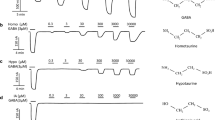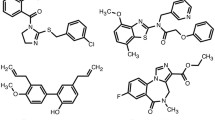Abstract
GABAC receptors play a role in myopia, memory-related disorders and circadian rhythms signifying a need to develop potent and selective agents for this class of receptors. Guanidino analogs related to glycine, β-alanine and taurine were evaluated at human ρ1GABAC receptors expressed in Xenopus oocytes using 2-electrode voltage clamp methods. Of the 12 analogs tested, 8 analogs were active as antagonists and the remaining were inactive. (S)-2-Guanidinopropionic acid (IC50 = 2.2 μM) and guanidinoacetic acid (IC50 = 5.4 μM; K B = 7.75 μM [pK B = 5.11 ± 0.06]) were the most potent being competitive antagonists at this receptor. In contrast, the β-alanine and GABA guanidino analogs showed reduced activity, indicating the distance between the carboxyl carbon and terminal nitrogen of the guanidino group is critical for activity. Substituting the C2-position of guanidinoacetic acid with various alkyl groups reduced activity indicating that steric effects may impact on activity. The results of this study contribute to the structure–activity-relationship profile required in developing novel therapeutic agents.




Similar content being viewed by others
Abbreviations
- TPMPA:
-
(1,2,5,6-Tetrahydropyridin-4-yl)methylphosphinic acid
- CACA:
-
(Z)-4-Aminobut-2-enoic acid
- (+)-CAMP:
-
(+)-cis-2-Aminomethylcyclopropanecarboxylic acid
- cis- and trans-3-ACPBPA:
-
cis- and trans-(3-aminocyclopentanyl)butylphosphinic acid
- ZAPA:
-
(Z)-3-[(Aminoiminomethyl)thio]prop-2-enoic acid
- (R)- and (S)-2-Me-GABA:
-
(R)- and (S)-4-Amino-2-methyl-butyric acid
- GAA:
-
Guanidinoacetic acid
- 5-MeIAA:
-
5-Methyl imidazole-4-acetic acid
References
Bormann J (2000) The ‘ABC’ of GABA receptors. Trends Pharmacol Sci 21:16–19. doi:10.1016/S0165-6147(99)01413-3
Chebib M, Johnston GAR (2000) GABA activated ion channels: medicinal chemistry and molecular biology. J Med Chem 43:1427–1447. doi:10.1021/jm9904349
Duke RK, Chebib M, Allan RD et al (2000) (+)- and (−)- CAMP (cis-2-aminomethylcyclopropanecarboxylic acid), show opposite pharmacology at recombinant ρ1 and ρ2 GABAC receptors. J Neurochem 75:2602–2610. doi:10.1046/j.1471-4159.2000.0752602.x
Madsen C, Jensen AA, Liljefors T et al (2007) 5-substituted imidazole-4-acetic acid analogues: synthesis, modeling, and pharmacological characterization of a series of novel γ-aminobutyric acidc receptor agonists. J Med Chem 50:4147–4161. doi:10.1021/jm070447j
Murata Y, Woodward RM, Miledi R, Overman LE (1996) The first selective antagonist for a GABAC receptor. Bioorg Med Chem Lett 6:964–968. doi:10.1016/0960-894X(96)00364-2
Ragazzino D, Woodward RM, Murata Y et al (1996) Design and in vitro pharmacology of a selective γ-aminobutyric acidC receptor antagonist. Mol Pharmacol 50:1024–1030
Hanrahan JR, Mewett KN, Chebib M et al (2006) Diastereoselective synthesis of (3-aminocyclopentanyl)alkylphosphinic acids, conformationally restricted analogues of GABA. Org Biomol Chem 4:2642–2649. doi:10.1039/b604002k
Chebib M, Hanrahan JR, Kumar RJ et al (2007) (3-Aminocyclopentyl)methylphosphinic acids: novel GABAC receptor antagonists. Neuropharmacology 52:779–787. doi:10.1016/j.neuropharm.2006.09.014
Chebib M, Hinton T, Schmid KL et al (2009) Novel, potent and selective GABAC antagonists inhibit myopia development and facilitate learning and memory. JPET 328:448–457. doi:10.1124/jpet.108.146464
Kumar RJ, Chebib M, Hibbs DE et al (2008) Novel gamma-aminobutyric acid rho1 receptor antagonists; synthesis, pharmacological activity and structure–activity relationships. J Med Chem 51:3825–3840. doi:10.1021/jm7015842
Gibbs ME, Johnson GAR (2005) Opposing roles for GABAA and GABAC receptors in short-term memory formation in young chicks. Neuroscience 131:567–576. doi:10.1016/j.neuroscience.2004.11.033
Arnaud C, Gauthier P, Gottesmann C (2001) Study of a GABAC receptor antagonist on sleep-waking behavior in rats. Psychopharmacology (Berl) 154:415–419. doi:10.1007/s002130000653
Johnston GAR, Chebib M, Hanrahan JR et al (2003) GABAC receptors as drug targets. Curr Drug Target CNS Neurol Disord 2:260–268. doi:10.2174/1568007033482805
Boue-Grabot E, Taupignon A, Tramu G, Garret M (2000) Molecular and electrophysiological evidence for a GABAC receptor in thyrotropin-secreting cells. Endocrinology 141:1627–1632. doi:10.1210/en.141.5.1627
Jansen A, Hoepfner M, Herzig K-H et al (2000) GABAC receptors in neuroendocrine gut cells: a new GABA-binding site in the gut. Pflugers Arch 441:294–300. doi:10.1007/s004240000412
Curtis DR, Watkins JC (1965) The pharmacology of amino acids related to gamma-aminobutyric acid. Pharmacol Rev 17:347–391
Neu A, Neuhoff H, Trube G et al (2002) Activation of GABAA receptors by guanidinoacetate: a novel pathophysiological mechanism. Neurobiol Dis 11:298–307. doi:10.1006/nbdi.2002.0547
Allan RD, Dickenson HW, Hiern BP, Johnston GAR et al (1986) Isothiouronium compounds as gamma-aminobutyric acid agonists. Br J Pharmacol 88:379–387
Allan RD, Dickenson HW, Johnston GAR et al (1997) Structural analogues of ZAPA as GABAA agonist. Neurochem Int 30:583–591. doi:10.1016/S0197-0186(96)00094-0
Woodward RM, Polenzani L, Miledi R (1993) Characterization of bicuculline/baclofen-insensitive (rho-like) gamma-aminobutyric acid receptors expressed in Xenopus oocytes. II. Pharmacology of gamma-aminobutyric acidA and gamma-aminobutyric acidB receptor agonists and antagonists. Mol Pharmacol 43:609–625
Kerr DI, Humeniuk RE, Ong J (1994) Gamma-guanidinobaclofen is a peripheral GABAB receptor agonist. Eur J Pharmacol 262:189–192. doi:10.1016/0014-2999(94)90046-9
Calvo DJ, Miledi R (1995) Activation of GABA ρ1 receptors by glycine and β-alanine. NeuroReport 6:1118–1120
Pan Y, Khalili P, Ropps H et al (2005) Pharmacology of GABAC receptors: responses to agonists and antagonists distinguish A- and B-subtypes of homomeric receptors expressed in Xenopus oocytes. Neurosci Lett 376:60–65. doi:10.1016/j.neulet.2004.11.024
Ochoa-de la Paz LD, Martinez-Dávila IA, Miledi R, Martinez-Torres A (2008) Modulation of human GABA rho1 receptors by taurine. Neurosci Res 61:302–308. doi:10.1016/j.neures.2008.03.009
Desveges G, Nguyen-Van T (1968) Hypotaurocyamine (2-guanidinoethanesulfinic acid). C R Seances Acad Sci C 267:1868–1870
Fasold H, Turba F, Wirsching W (1961) Preparation and chromatographic separation of guanidino amino acids. Biochem Z 335:86–91
Miller AE, Bischoff JJ (1986) A facile conversion of amino acids to guanidino acids. Synthesis 77:7–779. doi:10.1055/s-1986-31777
Chebib M, Vandenberg RJ, Froestl W, Johnston GAR (1997) Unsaturated phosphinic analogues of γ-aminobutyric acid as GABAC receptor antagonists. Eur J Pharmacol 329:223–239
Arunlakshana O, Schild HO (1959) Some quantitative uses of drug antagonists. Br J Pharmacol Chemotherap 14:48–58
Chebib M, Vandenberg RJ, Johnston GAR (1997) Analogues of gamma-aminobutyric acid (GABA) and trans-4-aminocrotonic acid (TACA) substituted in the 2 position as GABAC receptor antagonists. Br J Pharmacol 122:1551–1560. doi:10.1038/sj.bjp.0701533
Crittenden DL, Chebib M, Jordan MJT (2005) A quantitative structure–activity relationship investigation into agonist binding at GABAC receptors. Theochem 755:81–89. doi:10.1016/j.theochem.2005.07.029
Crittenden DL, Park A, Qiu J et al (2006) Enantiomers of cis-constrained and flexible 2-substituted GABA analogues exert opposite effects at recombinant GABAC receptors. Bioorg Med Chem 14:447–455. doi:10.1016/j.bmc.2005.08.037
Abdel-Halim H, Hanrahan JR, Hibbs DE et al (2008) A molecular basis for agonist and antagonist actions at GABAC receptors. Chem Biol Drug Des 71:306–327. doi:10.1111/j.1747-0285.2008.00642.x
Marescau B, Deshmukh DR, Kockx M et al (1992) Guanidino compounds in serum, urine, liver, kidney, and brain of man and some ureotelic animals. Metabolism 41:526–532. doi:10.1016/0026-0495(92)90213-T
Zugno AI, Oliveira DL, Scherer EBS et al (2007) Contact information guanidinoacetate inhibits glutamate uptake in rat striatum of rats at different ages. Neurochem Res 32:959–964
Cupello A, Balestrino M, Gatta E et al (2008) Activation of cerebellar granule cells GABA(A) receptors by guanidinoacetate. Neuroscience 152:65–69. doi:10.1016/j.neuroscience.2007.12.018
Koga Y, Takahashi H, Oikawa D et al (2005) Brain creatine functions to attenuate acute stress responses through GABAnergic system in chicks. Neuroscience 132:65–71. doi:10.1016/j.neuroscience.2005.01.004
Iversen LL, Johnston GAR (1971) γ-Aminobutyric acid uptake in rat central nervous system. Comparison of uptake in slices and homogenates and the effects of some inhibitors. J Neurochem 18:1939–1950. doi:10.1111/j.1471-4159.1971.tb09600.x
Acknowledgments
We are very grateful for the National Health and Medical Research Council of Australia for financial support and the Department of Pharmacology, The University of Sydney, for managing and maintaining the Xenopus laevis colony. N.G. acknowledges support from an Endevour International Postgraduate Scholarship and the John Lamberton top-up scholarship.
Author information
Authors and Affiliations
Corresponding author
Rights and permissions
About this article
Cite this article
Chebib, M., Gavande, N., Wong, K.Y. et al. Guanidino Acids Act as ρ1 GABAC Receptor Antagonists. Neurochem Res 34, 1704–1711 (2009). https://doi.org/10.1007/s11064-009-9968-x
Received:
Accepted:
Published:
Issue Date:
DOI: https://doi.org/10.1007/s11064-009-9968-x




